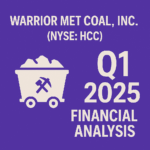Alpha Metallurgical Resources, Inc. (NYSE: AMR)
Q2 2025 Financial Analysis | August 8, 2025
Executive Summary
Alpha Metallurgical Resources reported a challenging but operationally improved second quarter 2025, posting a net loss of $5.0 million compared to net income of $58.9 million in Q2 2024. Despite revenue headwinds, the company achieved significant operational improvements with cost of coal sales decreasing to $100.06 per ton from $110.34 per ton in Q1, representing the best quarterly cost performance since 2021. Adjusted EBITDA of $46.1 million, while down from $116.0 million in the prior year, showed substantial improvement from Q1 2025’s $5.7 million. The company maintains strong liquidity with $556.9 million in total liquidity as of June 30, positioning it well to navigate market challenges and capitalize on opportunities.
Q2 2025 Highlights
Financial Performance
Alpha’s Q2 2025 financial results reflected the challenging metallurgical coal market environment, with total revenue declining 32% year-over-year to $550.3 million. Coal revenue of $548.7 million was down 31% from $800.1 million in Q2 2024, primarily driven by lower volumes (3.9 million tons versus 4.6 million tons) and reduced pricing ($119.43 per ton versus $141.86 per ton).
The company posted a net loss of $5.0 million or $0.38 per diluted share compared to net income of $58.9 million or $4.49 per diluted share in Q2 2024. However, this represented a significant sequential improvement from Q1 2025’s net loss of $33.9 million, demonstrating the effectiveness of the company’s cost reduction initiatives and operational improvements.
Adjusted EBITDA of $46.1 million showed substantial quarter-over-quarter recovery from Q1 2025’s $5.7 million, although down from $116.0 million in the prior year period. This improvement was primarily driven by the significant reduction in cost of coal sales per ton and improved operational efficiency.
Operating cash flow of $53.2 million, while down 61% year-over-year, represented a meaningful improvement from Q1 2025’s $22.2 million. The company’s capital expenditures of $34.6 million were lower than the prior year’s $61.1 million, reflecting disciplined capital allocation in the current market environment.
The financial performance demonstrates management’s focus on operational efficiency and cost management during a challenging market cycle, with the company successfully reducing costs while maintaining production capabilities.
Operational Performance & Sales Mix
| Sales Category | Tons Sold (M) | Revenue ($M) | Realization ($/ton) | % of Met Tons |
|---|---|---|---|---|
| Export – Other Pricing | 1.7 | $191.6 | $113.82 | 47% |
| Domestic | 0.9 | $143.8 | $152.28 | 26% |
| Export – Australian Indexed | 1.0 | $105.7 | $109.75 | 27% |
| Total Met Coal | 3.6 | $441.0 | $122.84 | 100% |
| Thermal Coal | 0.3 | $23.1 | $78.01 | – |
Alpha’s operational performance in Q2 2025 showed mixed results across different sales channels. Total coal sales decreased to 3.9 million tons from 4.6 million tons in the prior year, reflecting both market conditions and strategic operational decisions.
The sales mix revealed interesting dynamics, with domestic sales commanding the highest realization at $152.28 per ton, representing 26% of metallurgical coal volumes. Export sales to other pricing mechanisms accounted for the largest volume share at 47% with a realization of $113.82 per ton, while Australian-indexed export sales represented 27% of volumes at $109.75 per ton.
The company’s metallurgical coal sales realization of $122.84 per ton for the Met segment reflected the challenging pricing environment, particularly in export markets. However, the diversified sales portfolio helped maintain revenue stability across different pricing mechanisms and geographic markets.
Thermal coal operations, while a smaller component of the business, generated $23.1 million in revenue from 0.3 million tons at an average realization of $78.01 per ton. This segment provides additional cash flow diversification for the company.
The operational metrics demonstrate Alpha’s ability to maintain production flexibility and market responsiveness, positioning the company to capitalize on pricing improvements when market conditions recover.
Cost Management & Operational Efficiency
Alpha delivered impressive cost management results in Q2 2025, achieving its best quarterly cost of coal sales performance since 2021 at $100.06 per ton, a significant improvement from $110.34 per ton in Q1 2025. This $10.28 per ton reduction represents the effectiveness of the company’s cost reduction initiatives.
The primary drivers of cost reduction included:
- Labor Optimization: Streamlined workforce and improved productivity through operational efficiency initiatives
- Supply Chain Management: Reduced supplies and materials costs through strategic procurement and vendor negotiations
- Operational Excellence: Implementation of best practices and process improvements across mining operations
- Maintenance Efficiency: Optimized maintenance schedules and reduced equipment downtime
The non-GAAP coal margin improved to $19.36 per ton from $8.27 per ton in Q1, demonstrating the substantial impact of cost management initiatives even in a challenging pricing environment. This margin expansion of over $11 per ton quarter-over-quarter shows the company’s operational leverage.
Management’s decision to lower the full-year 2025 cost of coal sales guidance to $101.00 to $107.00 per ton, down from $103.00 to $110.00 per ton, reflects confidence in sustaining these operational improvements throughout the remainder of the year.
The cost management success positions Alpha competitively in the market and provides operational flexibility to respond to market opportunities while maintaining profitability even at lower pricing levels.
Liquidity & Balance Sheet Strength
Alpha maintains exceptionally strong financial position with robust liquidity and minimal debt obligations:
- Total Liquidity: $556.9 million as of June 30, 2025, providing substantial financial flexibility
- Cash Position: $449.0 million in cash and cash equivalents, up from previous periods
- Credit Facility: $182.9 million of unused availability under asset-based revolving credit facility
- Debt Profile: Minimal total long-term debt of $5.8 million including current portion
- Letters of Credit: $42.1 million outstanding under ABL facility
The company’s balance sheet metrics demonstrate financial stability:
- Total assets of $2.37 billion as of June 30, 2025
- Stockholders’ equity of $1.61 billion
- Strong working capital position with current assets of $988.2 million
- Property, plant, and equipment net of $624.1 million
- Mineral rights valued at $428.4 million net of accumulated depletion
The strong liquidity position resulted from disciplined cash management and improved operating cash flow generation. CEO Andy Eidson noted: “I am pleased to report that we had total liquidity of $557 million as of June 30, which is the culmination of our teams working together to position ourselves to capitalize on opportunities.”
This financial strength provides Alpha with strategic flexibility to navigate market cycles, invest in growth opportunities, and return capital to shareholders when appropriate market conditions return.
2025 Guidance & Market Outlook
Alpha updated its 2025 guidance across multiple categories, reflecting improved operational performance and updated market expectations:
Updated Guidance Ranges
- Cost of Coal Sales: $101.00 – $107.00 per ton (reduced from $103.00 – $110.00)
- SG&A Expenses: $48 – $54 million (reduced from $53 – $59 million)
- Net Cash Interest Income: $6 – $12 million (increased from $2 – $10 million)
- Idle Operations Expense: $21 – $29 million (increased from $18 – $28 million)
- DD&A: $165 – $185 million
- Capital Expenditures: $130 – $150 million
- Capital Contributions to Equity Affiliates: $44 – $54 million
Production & Sales Expectations
- Metallurgical Coal: 13.8 – 14.8 million tons
- Thermal Coal: 0.8 – 1.2 million tons
- Total Met Segment Shipments: 14.6 – 16.0 million tons
As of July 30, 2025, Alpha has committed and priced approximately 69% of its metallurgical coal for 2025 at an average price of $127.37 per ton. The company also has 100% of its thermal coal committed at an average price of $80.52 per ton, providing revenue visibility for the remainder of the year.
The domestic metallurgical coal portfolio commands a premium at $152.21 per ton, while export metallurgical coal averages $112.17 per ton. This pricing differential highlights the strength of domestic steel demand and the company’s strategic positioning in North American markets.
Strategic Initiatives & Tax Credit Benefits
Alpha is positioned to benefit from significant strategic developments and policy changes that should provide additional value and liquidity:
Section 45X Tax Credit
On July 4, 2025, the “One Big Beautiful Bill Act” (OBBBA) was signed into law, adding metallurgical coal to the list of “applicable critical minerals” for purposes of the Section 45X credit. This refundable tax credit provides:
- 2.5% of production costs for metallurgical coal produced during tax years 2026-2029
- Estimated annual cash benefit of $30-50 million depending on qualifying production costs
- Additional source of liquidity in future years
- Recognition of metallurgical coal’s critical importance to steel production
Share Repurchase Program
Alpha’s board previously authorized a $1.5 billion share repurchase program with approximately $400 million remaining authorization. While the company refrained from repurchases during the recent market softness to strengthen liquidity, management plans to restart the program on an opportunistic basis given the improved financial position.
Operational Excellence Initiatives
- Continued focus on cost reduction and operational efficiency
- Strategic workforce optimization and productivity improvements
- Supply chain optimization and vendor relationship management
- Technology adoption to improve mining efficiency and safety
- Environmental and sustainability initiatives
These strategic initiatives position Alpha to maximize value creation for shareholders while maintaining operational excellence and financial discipline during market cycles.
Risks & Opportunities
Opportunities
Risks
Conclusion
Strengths
- Best quarterly cost performance since 2021 at $100.06 per ton
- Strong liquidity position of $556.9 million provides financial flexibility
- Significant improvement in Adjusted EBITDA to $46.1M from $5.7M sequentially
- Upcoming Section 45X tax credit benefits of $30-50 million annually
- Minimal debt profile with only $5.8 million total debt
Areas of Focus
- Navigating continued pricing pressure in metallurgical coal markets
- Maintaining operational efficiency gains achieved in Q2
- Managing production levels to match market demand
- Optimizing capital allocation in challenging market environment
- Monitoring global steel demand trends and trade dynamics
Summary
Alpha Metallurgical Resources demonstrated operational resilience in Q2 2025, achieving significant cost improvements despite challenging market conditions. The company delivered its best quarterly cost performance since 2021 at $100.06 per ton, representing a $10.28 improvement from Q1 and driving Adjusted EBITDA recovery to $46.1 million.
While revenue and volumes declined due to market pressures, Alpha’s strong balance sheet with $556.9 million in liquidity positions the company well to navigate the current cycle. The upcoming Section 45X tax credit provides an additional $30-50 million in annual benefits starting in 2026, recognizing metallurgical coal’s critical importance to steel production.
Management’s disciplined approach to cost management, combined with strategic guidance updates showing confidence in sustaining operational improvements, demonstrates the company’s commitment to maximizing value through market cycles. With substantial liquidity, minimal debt, and operational flexibility, Alpha is well-positioned to capitalize on market recovery while maintaining financial strength.
The company’s ability to generate positive Adjusted EBITDA and operating cash flow even in challenging conditions, combined with its strategic positioning in domestic markets commanding premium pricing, provides a foundation for long-term value creation as market conditions improve.
Source: Alpha Metallurgical Resources Q2 2025 Earnings Release


